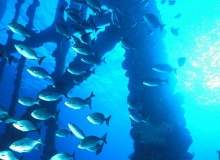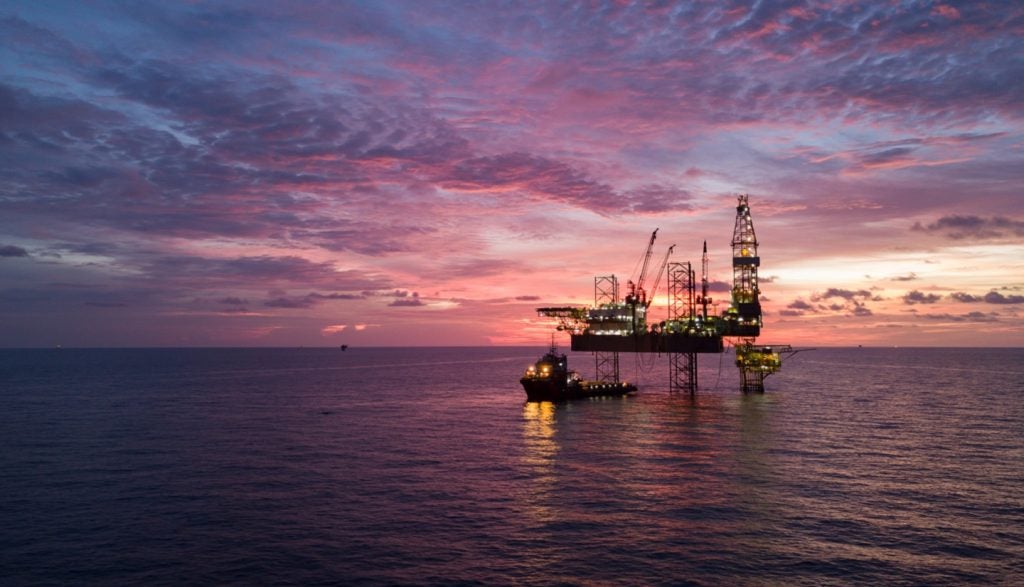

In the UK North Sea, around 470,000 tonnes of offshore assets – including platforms, pipelines and wells – will need to be taken offline and recovered between 2013 and 2022. The cost for decommissioning during this period has been estimated at around £10.4bn. Despite the UK government’s commitment to cushioning the industry from the costs of decommissioning through a 50% tax break, the prospect of shifting such a colossal mass of material is one of the major issues facing the North Sea, along with other highly developed offshore oil hubs.
As a result of these concerns, new methods to reuse decommissioned oil platforms – reducing decommissioning costs and eliminating the need to tear down offshore structures – are beginning to emerge. Some old platforms have already been used or considered for offshore diving centres, rigs-to-reefs projects are picking up steam in the US, and platforms could even play host to luxurious resort hotels.
One concept that seems a particularly good fit for the offshore oil environment is converting old rigs into hubs for mariculture, or deep-sea fish farming. The idea has been floating around for a few years but has yet to build any significant momentum. There are researchers, however, who want to change that. A project kicked off at Curtin University Sarawak in Malaysian Borneo in late 2012 was looking into the feasibility of oil platform-based fish farming in Malaysian waters.
Mechanical engineering specialist Dr. Ulugbek Azimov, a member of the initial research team at Curtin Sarawak, has since moved on to become a senior lecturer at the UK’s Northumbria University, where he has continued the research with a few enterprising students. We caught up with Azimov to get the latest on his studies into this fascinating offshore conversion process.
See Also:
Chris Lo: Has there been other work done in this area before your project at Curtin Sarawak?
Dr. Ulugbek Azimov: It’s not a new idea, but there are different approaches to turn decommissioned platforms into certain facilities. People tried to build a hotel on top of [a platform], a five-star hotel. In Malaysia, in Labuan, we found that they turned a platform into a diving centre. But that platform wasn’t a drilling platform, it was an auxiliary platform. Some people have mentioned turning decommissioned platforms into mariculture facilities, but we haven’t seen any detailed exploration or engineering proposals or drawings or anything like that.
How well do you really know your competitors?
Access the most comprehensive Company Profiles on the market, powered by GlobalData. Save hours of research. Gain competitive edge.

Thank you!
Your download email will arrive shortly
Not ready to buy yet? Download a free sample
We are confident about the unique quality of our Company Profiles. However, we want you to make the most beneficial decision for your business, so we offer a free sample that you can download by submitting the below form
By GlobalDataSo we thought that we could probably develop a project where people with different backgrounds can be involved. For example, initially we were four people – myself in mechanical engineering, one lecturer from civil engineering, and then Lisa King, a marine biologist. We tried to develop a project – at least a proposal – so that we would consider not only the structure, but also issues like rig-to-reef and so on.
Modern rigs cost millions of dollars and can weigh up to 30,000 tons. So what does it take to move these engineering marvels?
CL: What was the initial inspiration to begin this research at Curtin Sarawak?
UA: We got information from Petronas, the oil and gas company. We got some information that there are several platforms to be decommissioned in the future, and we even got some unofficial meetings with some Petronas representatives about this. They were quite interested in the project; however, there are so many complexities involved because to decommission a platform costs a huge amount of money, and then the oil and gas company will always bear the responsibility for it. So they said they had some platforms to be decommissioned in the near future and were willing to collaborate.
Probably they would allow us to do some investigation around the platform to find out what kinds of species we could farm there and so on. But as far as the engineering and construction is concerned, then we would probably first go for a small prototype model, and then go to the public, including the government, and convince them that this is a good idea. So the inspiration was basically to spread this information and awareness about this topic.
CL: What has been the progress on the project between 2012 and now?
UA: I moved to Northumbria University in the UK and I continued this myself, although I heard from my colleagues that they have presented some information at local conferences in Malaysia. But here, I initiated final-year projects. So for example, one student investigated the application of renewable energy technologies on decommissioned platforms, in particular wave generation devices and technologies. The second part of the mariculture project was to design the fish farm on top of a decommissioned platform.
The initial idea was to design a self-sustainable mariculture facility or fish farm. The students did a great job – one investigated and did a very deep feasibility study on this [concept] around the UK. He picked the platform to be decommissioned, I think it’s called the Murchison platform, which is due to be decommissioned in 2014, and then he [designed] all the wave generation facilities on top of it. Another student designed the entire fish farm. So now it’s going well. I hope I will publish these results and maybe submit a paper next month. It’s now in preparation, with some quite new ideas and interesting figures.
CL: Is the industry in the UK North Sea expressing any interest in this idea?
UA: My plan was after we complete these studies and publish some materials, I would probably apply for some government grants. There are several bodies that offer grants to check the feasibility of the idea. It may be the Royal Society or it may be the EPSRC [Engineering and Physical Sciences Research Council], or it may be some collaboration with colleagues from other European universities. But what we need first is a complete design and all the calculations, and then we will build a prototype, probably a small-scale prototype, to be able to demonstrate how it works and supplement with some data and calculations from the feasibility study.
After we get equipped with all of these things, then probably we can try to approach a company. But this issue is very complicated. Oil and gas companies may not be immediately interested in this. So we need some support from government, I believe.
CL: Given the cost of decommissioning, do oil and gas companies have an incentive to allow their platforms to be converted for new uses after the end of their operating lives?
UA: Yes. If you look at the most expensive portion of the process is to remove the structure. In fact, there was a paper published earlier this year in a journal called Marine Structures. The authors precisely explain the entire procedure and the cost involved, and you see that to remove the structure it will cost a minimum of $10 million. They would probably still have to remove the pipelines and do some work on it, but as far as the structure is concerned, if the responsibility is somehow shared and distributed among government or a third-party company that wants to build mariculture facilities, then I believe it will be a very good incentive and a good way to go for oil and gas companies to save some money and at the same time to protect the environment.
CL: What characteristics of offshore oil platforms make them suitable for mariculture?
UA: I think the first would be the location. For example, this student of mine did this research, and then he got some data from government bodies on the distribution of rigs, the wave heights and so on. The other factor may be what type of species we want to farm there, and also the platforms have different types – there are semi-submersibles and other types like the compliant towers and so on. So I think we haven’t investigated in detail this part yet, because our objective now is to build the structure, to design certain engineering technology for the farm, and then we will modify it based on the location and the wave height and other parameters.
CL: Are water conditions around oil platforms suited to supporting fish farming?
UA: Yes; I mentioned Lisa King from Curtin Sarawak. She did some studies on it, and she found that, in fact, fish mass is accumulated in that area. That’s why the idea of rig-to-reef came out several years ago. So the idea was that the environment around [oil platforms] was quite suitable for the fish mass to accumulate. If we build a farm, for example, and those facilities are there, it may create some type of oasis in this territory around the platform for the fish there.
Disused oil rigs have become home to millions of ocean creatures in the Gulf of Mexico, but hundreds of habitats could soon be wiped out.
CL: The idea has moved from Malaysian waters to the North Sea – do you think the idea is flexible and could work in a range of offshore regions?
UA: We only selected Malaysian waters because we were in Malaysia, and there were several platforms due to be available. And then also the companies like there, like Petronas and some other sub-contractors. So we thought it would be much easier to approach and then discuss.
But in general, I am now making it applicable to UK waters. In fact, when I was in Malaysia I got some contacts with a person from a company in Miami in the United States. They were doing some quite extensive research on offshore mariculture in the United States, in particular in the Miami area.
CL: What are the environmental benefits of converting oil platforms into mariculture hubs?
UA: Well, the first advantage is moving onshore aquaculture to offshore. There are many concerns about environmental issues coming from onshore aquaculture. You have diseases and the accumulation of waste, which is a huge issue now. If we move it offshore, then there will be continuous tidal movements, so the waste will be flushed away from the area, with continuous recirculation of waste.
Another issue is if we build the fish farm offshore, we need to supply energy somehow. So the idea of building a self-sustainable offshore farm can be very useful, and we can avoid this carbon footprint and make it ecologically clean and attractive.
CL: What are your hopes for spreading this idea in the future?
UA: Spreading this idea is what I’m trying to do, but I think to make it realistic and to convince the companies will be a very difficult task if we don’t get support from the government. The government should be involved somehow in this because we can design, get grants, build a prototype, but oil and gas companies are very conservative.
[Oil companies] could say ‘Okay, we can transfer the liability for you, so we can sell you the platform for $1, but ultimately you need to take care of it and you need to decommission it.’ Third-party companies may not go this way, because they don’t have that much money. The government, on the other hand, could use administrative resources somehow, and make some arrangement between the government and the company about who will be responsible and how it’s going to work. Then I think this idea will be attractive. Otherwise, for me it’s very complicated to make it realistic in the near future.

.gif)


